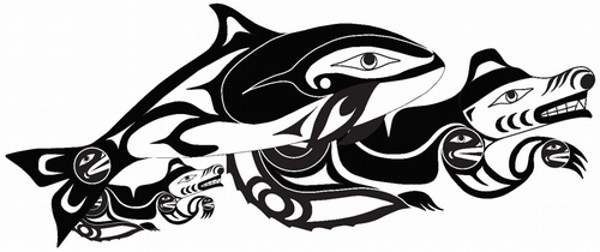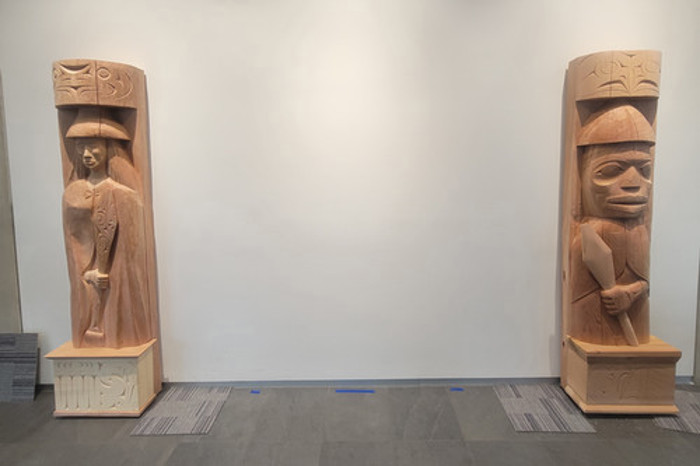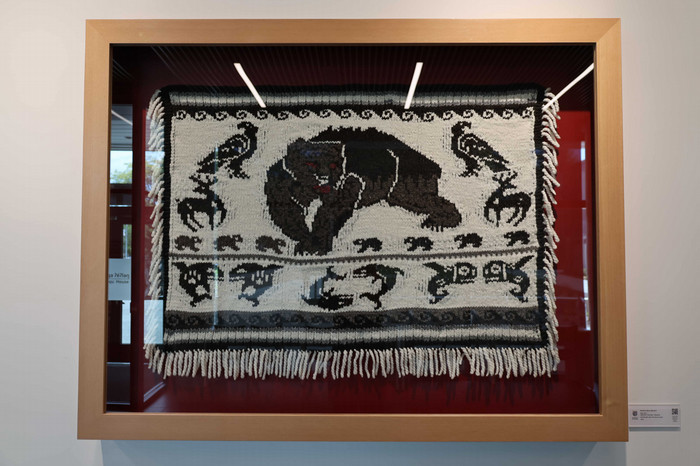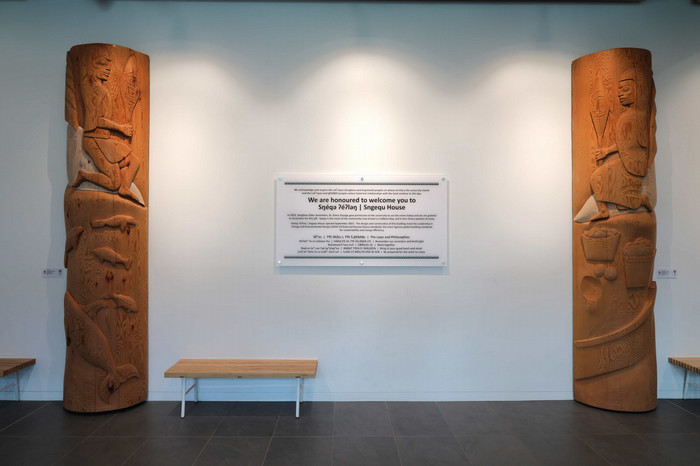Indigenization Project Summary
In 2017, the Student Services department (now Student Development and Success) together with the Office of Indigenous Academic and Community Engagement (IACE), embarked on a journey to develop a new approach for naming UVic’s two new residence facilities and an older residence building Lansdowne Residence One (formerly called Joseph Trutch). The project was undertaken in response to the goals of the University of Victoria’s (UVic) Strategic Framework, Indigenous Plan, Campus Master Plan and the aspirations of the Truth and Reconciliation Commission Report’s 94 Calls to Action.
Consultations with Lək̓ʷəŋən leaders from Songhees and Xʷsepsəm/Esquimalt First Nations and their past and present Indigenous students led to working with Songhees Elder Čeyɫəm, Dr. Elmer George. Čeyɫəm provided the three names and permission for their use, and Indigenous language revitalization became a core goal of the initiative. UVic agreed that it was important to seek Indigenous names that would be deeply grounded in the history of land and language and would meaningfully honour the Lək̓ʷəŋən people and the university’s relationship with them.
Čeqʷəŋín ʔéʔləŋ | Cheko’nien House opened in September 2022 and Sŋéqə ʔéʔləŋ | Sngequ House opened a year later. The Indigenization Project was initiated to further fulfil UVic’s goal of truth and reconciliation, to continue to cultivate good relationships with the local First Nations, and ultimately to pay respect and honour the Indigenous names. The approach to indigenize the buildings was two-fold, using meaningful art and Indigenous language as the methods of expression.
Historically, Indigenous people did not create art for art’s sake because the artwork always had purpose. In Čeqʷəŋín ʔéʔləŋ | Cheko’nien House and Sŋéqə ʔéʔləŋ | Sngequ House there is an important story to tell with each piece on display. To learn more about the Indigenous people, you are encouraged to use the QR codes to read the story of the art and the artist biography. In addition to the art, there are numerous Indigenous language signs throughout the buildings and viewers are encouraged to use the QR codes to learn the Lək̓ʷəŋən names and teachings.
By reading the stories, biographies and learning the meanings of the Indigenous language signs, you are expanding your knowledge and contributing to decolonization.
SIÁM SȽEȽWÁȽ NOṈET SWEꞢE,Ƚ (Highly Respected One's, Peace of Mind at Last)

Location: Čeqʷəŋín ʔéʔləŋ | Cheko’nien House, Upstairs student dining
Blanket name, interpretation and translation, provided by J,SIṈTEN, Dr. John Elliott.
The ‘Highly Respected One's, Peace of Mind at Last’ Coast Salish Woven Blanket made by Myrna Crossley is made with the intention of sharing values and teachings of the land, with acknowledgement of the First Peoples and their important teachings.
Myrna Crossley’s husband, the late Master Coast Salish Carver/Artist TEMOSEṈ-ŦET Charles Elliott, talked about how art is an act of resurgence and resistance, and that by weaving blankets, including this blanket, the wet moldy blanket of oppression and colonization is being lifted off their backs and being replaced with a blanket that belongs to their culture.
The designs of Salish Woven Blankets vary, and the colours and shapes usually carry special meaning for the Blanket wearer. The bands of colour that border across the four large triangles represent our connection to the land and the four larger triangle designs are bordered by four brown triangles on the outer edge and they represent the steps a person needs to take to achieve their goals.
The inner squares of the various colours represent the family and community that have assisted the wearer to achieve their goals—each person has a gift to share. The yellow half-triangles represent each new day, and the blue T design represents the wearer on their journey, surrounded by the love and teachings of their family and community.
The alternating horizontal V shape represent the ongoing change in one’s life. The triangles of orange and brown represent man and woman and movement in life. The alternating upright lines of colour represent the steadfast teachings and beliefs that the wearer carries. The white areas represent the ongoing teachings that carries one through life.
In the creation of the design, the weft weave can be varied with a twine weave or a twill weave. The twine weave wraps around each warp and the twill goes over and under the warp. Variations of both will produce patterns. The twine is used for designing triangles, squares and solid lines that are woven tightly using different colours; and the twill weave produces a looser patterned weave. The more intricate designed blankets will be woven completely using the twine weave.
Orca and the Wolves

Location: Čeqʷəŋín ʔéʔləŋ | Cheko’nien House
The story of the Orca Whales and Wolves being distant relatives goes back hundreds of years. Perhaps it is due to the markings being similar, hunting patterns or how they migrate in packs? Since this story goes back to my early ancestors, I have included the symbol of my ancestry on both the Orca and Wolf.
Family is culturally the single most important purpose of my life and to my Indigenous people of the West Coast. It is equally important in nature. This gift ties nature to humanity and continues to humble those who honour our traditional ways.
Hay’sxw’qa si’em (hych’ka sea-em)!
ḴAḴEN SȽÁNI / Woman House Post (Left)

Location: Čeqʷəŋín ʔéʔləŋ | Cheko’nien House, Cafeteria Side Entrance
ḴAḴEN SȽÁNI / Woman House Post story by TEMOSEṈ / Charles (Chazz) Elliott
Carved of ancient red cedar this sculpture is symbolic of the traditional Salish house posts. Often house posts were used structurally as pillars to support homes and decoratively to represent the families and stories of the homes. Each carving had its own meaning unique to the family and house.
This carving is of a female welcome figure, wrapped in her blanket wearing her cedar hat. She holds a paddle with the kingfisher design carved in the paddle. The paddle is positioned upright in a welcoming gesture, and this also recognizes the waters as something that connects us rather than separates us. The kingfisher is symbolic to the area of where university resides.
At the top of the house post is a frog design, the frog signifies new beginnings in our culture and announces the start of a new year. At the bottom of the house post is a yellow cedar box, with a heron design carved in the front. The box represents the education, the knowledge, history, stories and teachings. The heron is an example of the virtues of timing, and patience that leads to those achievements.
The name ḴAḴEN means house post but it comes from the word for baby because it is something you raise up and grow to take care of.
ḴAḴEN SW͸ḴE¸ / Man House Post (Right)

Location: Čeqʷəŋín ʔéʔləŋ | Cheko’nien House, Cafeteria Side Entrance
ḴAḴEN SW͸ḴE¸ / Man House Post story by Douglas (Bear) Horne
This is a red cedar carving of a male welcome figure. The man holds his paddle to his left that signifies welcoming friends and loved ones to our lands. The paddle represents his life journey and is one of the tools he uses to travel and provide for his family. He wears a traditional wool blanket over his shoulders.
The box represents the knowledge he has gained throughout his life that he holds with him wherever he goes in his travels. The design on the box is of a young eagle that signifies the teaching he passes on to the younger generation, which represents the future of our people and the value that our older ones carry with them.
All of these teachings and traditions are shared with us through our stories and traditional practices.
The name ḴAḴEN means house post but it comes from the word for baby because it is something you raise up and grow to take care of.
Mother Bear Blanket

Location: Sŋéqə ʔéʔləŋ | Sngequ House, Classroom Entrance
This blanket was made with the mother bear at the center of the work, and it was designed with the idea of ‘wrapping each student with the love and protection of their home, family or loved ones’.
The mother bear is large and fierce, standing over her young ones, protecting them and guiding them on their journey. Her red eyes are a warning against those who would seek to harm her cubs and the hair standing up on her back are an indication that she will always be ready to safeguard her young. Her tongue is red to symbolize the importance of following the teachings, especially those from home and then those that will guide her young to where they need to go. The bear cubs are different colours to symbolize the diversity of humanity and that no matter your colour, you will always be protected.
Beside the mother bear are the smaller eagles and deer and they symbolize the land and air – but they are also symbolic of the teachers and staff that support and work with the students. They are located beside the mother bear indicating that they are important, but because they are smaller than the mother bear, they are not as ‘important’ as their families. The eagle and deer are separated from the water creatures to symbolize the fact that for many generations, Indigenous knowledge and teachings were not a part of the higher academic institution.
The three pairs of whales symbolize the family foundations that everyone comes from, and they are all different species of whales to indicate that we are not one race. They are also an indication of our understanding that, to grow we must have diversity and acceptance of our differences and similarities. They are located at the bottom of the blanket to indicate that they are the family foundation that students build on and they are positioned to be both playful and busy, as most families can be.
The border is cockle shells, and these are symbolic of a favourite childhood treat for young Coast Salish children. In days gone past, cockle shells were roasted on an open fire and children would love to chew on the rubbery meat. Cockle shells are not only tasty, they was also healthy and for those that used to enjoy this delight, it creates fond memories of a young, carefree time. They are at the top and bottom to indicate that we all start out with such delightful memories of our youth and at the end, if we are lucky, after our long journey through life, we can once again take time to enjoy the little delights, after a life well lived.
The blanket is displayed and not used, but the idea behind the design of the blanket is intended to let all students know that they are being symbolically wrapped with care by their loved ones as they embark on this part of their life journey.
Sŋéqə ʔéʔləŋ Spirit Dancers

Location: Sŋéqə ʔéʔləŋ | Sngequ House, Conference Hallway and etched into the glass doors at the entrances and in various locations throughout the building
Home
Sŋéqə ʔéʔləŋ is a home for many students – we, the staff, faculty and community members hold our hands up to them on their academic journey.
The spirit dancers celebrate the home and hold up the otter while the eagle and the heron give guidance. The serpent protects the dancers and their home.
Xʷkʷənəŋistəl | W̱ȻENEṈISTEL | Helping to move each other forward
Family
When you have somewhere to belong, that is home.
When you have someone to belong to, that is family.
Look within – you will find both are there.
The salmon provides nourishment to the bear, just as education nourishes the family.
ʔetalnəwəl | ÁTOL,NEUEL | Working together with respect for the rights of one another and all things
Eagle and Hummingbird

Location: Sŋéqə ʔéʔləŋ | Sngequ House, Conference stairwell, hallway and etched into glass throughout the building.
Eagle and Hummingbird
The eagle and hummingbird teach us that your strength comes from your mindset, your determination, and your passion to be yourself.
You have the strength and passion to fulfil your dreams, just remember your teachings.
Love
The truest form of power is intelligence demonstrated with a good heart and a good mind.
Eagle and hummingbird are intelligent beings with good hearts and good minds.
Nəw̓es šxʷ cən ʔay̓ šqʷeləqʷən | ÁMEḴT TŦEN ÍY, ŚḰÁLEȻEN | Bring in your good heart and mind
The Orca Matriarchs

Location: Sŋéqə ʔéʔləŋ | Sngequ House, Conference Hallway and etched into the glass doors and windows throughout the building.
The orca is courage, knowledge, family and love.
Just like the matriarchal orca society, we must learn to work together for the survival of our world – use our teachings that run through our DNA. Knowledge is our inheritance.
Unity
The orca symbolizes connection, protection and a sense of belonging.
Like the orca, you will travel in the academic world, create connections and seek protection and a sense of belonging. You will find your way when you work together.
Nəc̓əmaat kʷəns čeʔi | ĆȺNEUEL OL | Work together
Frogs and Lily Pads

Location: Sŋéqə ʔéʔləŋ | Sngequ House, Conference Hallway and etched into the glass doors and windows throughout the building.
Let the frog remind us to balance darkness and light. Frogs have the ability to cleanse bad spirits and they live in two worlds, the land and water. Frog is a good communicator.
As students, you live in two worlds, and you too have the ability to cleanse bad spirits and be a communicator.
The lily is full of reflection – in times of reflection, we learn to be stronger, better, and greater – these give us the continuance of life.
Trust
All of your ancestors' decisions and choices created this opportunity for you to be who you are meant to be!
The frogs trust that the lily pad is a safe place.
Héʔəkʷ ʔə cə čəléŋən ɫtə |HÁEQ ȽTE OL TŦE ĆELÁṈEN ȽTE | Remember our ancestors and birthright
Raven and the Moon

Location: Sŋéqə ʔéʔləŋ | Sngequ House, Conference Hallway and etched into the glass doors and windows throughout the building.
Raven is a curious, playful character who reminds us to be prepared and to always see the joy and pain in others. The moon keeps us steady – it regulates the flow of life on Mother Earth.
In your work, keep a steady pace, be courageous, be compassionate and have fun.
Together, the moon and raven remind us that we are never alone, even in the darkness.
Respect
Never shy away from the darkness, because that is where we learn that our strength always existed.
Raven is guided by the bright moon’s light.
Leʔt šxʷ helə ʔə cə mak̓ʷ sčeʔi səʔ | S,HOL EṮ MEQ EN ENÁ SE SĆȺ | Be prepared for the work to come
Cedar bark mat

Ceremony
For many Indigenous people, doing a ceremony was how they governed their personal and political lives. For example, in the hereditary system of leadership, a new Chief was always announced in ceremony and the people who attend and witness the event are the record keepers. In oral traditions, the role of the witness is vital. It is the witness’s responsibility to speak to what they witnessed, not only as part of the ceremony but also after the event, when speaking to the public.
In the past, planning for ceremonies used to be a minimum of four years, and it involved extraordinary preparations. The community hosting the ceremony had to prepare to house, feed, entertain and gift many guests often for ten days or more. Dancers and singers practiced regularly and they were required to follow daily cleansing protocols. The timing and synchronicity of their songs and dances had to be perfect because a misstep could allow supernatural forces to foil them. The cedar bark weavers worked daily to create the numerous items and gifts needed for the ceremony.
One of the items the weaver made were for the use of the host Chief, his wife and their special high-ranking guests. These were cedar bark mats that the leaders sat on during the event. In addition to identifying the leader’s seat at the ceremony, it also provided protection for their regalia. Intricate designs such as whaler canoes, whales and thunderbirds were woven into the edge.
Cultural Protocols
All cedar bark weavers are taught early that they must practice personal cultural protocols before they do any of their work. Cedar is sacred – that is the first teaching and everything the weaver does, from start to finish must be done with this in mind. The cedar weaver learns that they must start their work with a good heart and mind and if something doesn’t feel right, they had to cleanse themselves. They would pray and brush themselves with cedar boughs at regular early morning dips in their sacred spots in the ocean or a nearby fresh water source.
When gathering the bark, the weaver must pray and thank the Creator for the gift of the magnificent cedar tree, and they must thank the spirit of the tree for sharing a piece of itself and apologize for any harm caused by their actions. Only a portion of the bark is to be taken from the tree and the weaver prays for the trees recovery from the wound caused by the missing bark. If in another’s Indigenous territory, it is important that the weaver practice local protocols and gain permission to gather the bark.
Once the weaver starts to create the cedar mat, they think about the recipient and pray for that person’s protection and good will. When this prayer is performed on a regular basis while weaving, it is believed that the person using it would have some added protection from bad supernatural spirits.
The Canoe Journey Cedar Bark Mat
When making this mat, the design woven into the edge was made with the University of Victoria students in mind. The weaver thought about how the canoe and paddler symbolize the educational journey that students are on. The canoe is the university, the paddler is the student and the paddle they use is made from the fabric of their life and it takes them safely on their journey.
Prayers of good will and a prosperous future for the student are infused in the mat and the weaver thought about how she wanted the student to have memorable experiences, gain new insights and develop a better understanding of the Indigenous worldview.
The Hunter and the Gatherer

Location: Sŋéqə ʔéʔləŋ | Sngequ House, Classroom Entrance
House Posts by Tom LaFortune with the assistance of Eddy Cliffe.
Story of the Sŋéqə ʔéʔləŋ House posts.
Sŋéqə was a very important gathering and hunting area for the Lək̓ʷəŋən and W̱SÁNEĆ peoples and these house posts are representative of the activity that occurred in the area. The area was named for the snow drifts or patches of snow that appeared during the winter. It was also known as a feeding area for the whales because of the reefs that housed their food.
The Hunter house post represents a cycle of life where there are hunters and the hunted. There is a purpose and meaning in all activity. The hunters were traditionally men, and they hunted for the sustenance of their people. Seals hunt the salmon, and the salmon hunt the herring.
The Gatherer house post also represents a cycle of life where the gatherers work to feed the people. The gatherers were traditionally women and they would use deer antlers to gather the clams and they would paddle to their crab traps to gather seafood.
The man and woman are representative of family, and they are both holding paddles, the symbols of the Salish Sea highway that many used to travel. On the Hunter’s paddle is an Eagle moon who provides guidance for the mind and spirit. On the Gatherer’s paddle is an Otter moon who provides guidance for the body and soul.
